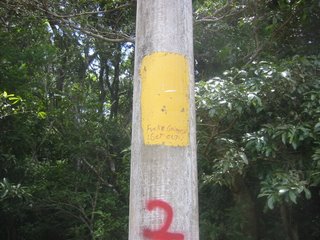gringos a go go
This is the only evidence I’ve seen of anti-gringo feeling, it’s on a lamp-post tucked away down a very quiet road. It’s fitting that the word ends in the sign for colones.
This area was bought in 1900 or thereabouts by a Tico gold company, a mine existed here until the late 30s when it became too expensive to run. By that time a very small community of farmers had grown around the miners, when the mine shut the miners became squatter farmers. In 1950 a group of Quakers from Alabama bought the land from the mining company and arrived along the oxen trail which led up from the lowlands. They were dairy farmers but milk doesn’t keep and so they began to experiment with different cheeses.
In the 70s conservation began and more gringos came to study the land. The influx of whites grew and today Monteverde receives more than 200,000 tourists a year. The resident community numbers around 5,000. The tourists have an enormous impact. Most stores take dollars and the bank provides accounts in both dollars and colones. I have two accounts which makes sense as the value of the colone drops slightly each day against the dollar, today for example there are 513 to the $. Monteverde is the most expensive part of Costa Rica, land prices are rising all the time. There is a house for sale in Monteverde, nice place going for $2.4 million. I get paid the going rate for Tico teachers - $5,000 a year. You can tell who’s not going to be able to afford to own homes in Monteverde. Last night I paid $3 for a pepsi, I was fairly shocked, but then again I was in a café which served braised chicken livers on a bed of wilted spinach: not exactly typical Tico fare.
Hotels abound here, restaurants, tourist offices, really there are too many competing against each other. This has been a slow year, numbers are down and the businesses are suffering. Almost all the business here is locally owned so the gringos have a very direct effect on the local economy.
An environmental effect too. The roads create a huge amount of water run-off creating erosion and slides further down the mountain. Water usage is on the increase so much so that some areas don’t have water during the dry season – incredible for an area that receives over 100 inches of rain a year. Buildings go up anywhere, anyhow without any planning or permits. Each little section has its own antiquated septic system. Water from laundry and shower goes straight into street drains. It’s a huge challenge. We have gone from an agricultural society to one based on eco-tourism and yet serving the tourists is destroying the environment. The balance has not been struck. I feel like an abuser myself trying to leave as little impact on the land as I can, but knowing that my presence here has the potential to tip the scales.
If the Quakers hadn’t come this might have remained a very sleepy agricultural area. Sooner or maybe later the forest might have been stripped away as the demand for hardwood lumber, particularly mahogany, rose. There might have been conservation attempts. But instead the Quakers immediately set aside protected land and it was the visiting scientists who began to buy land and raise awareness internationally of how important this area is. Without the gringos there would be no Monteverde.
This is a multi-lingual cosmopolitan area. While I understand the sentiment I’m growing more aligned to a global approach to land and nationality. Maybe there are gradations of gringo, I hope so.


